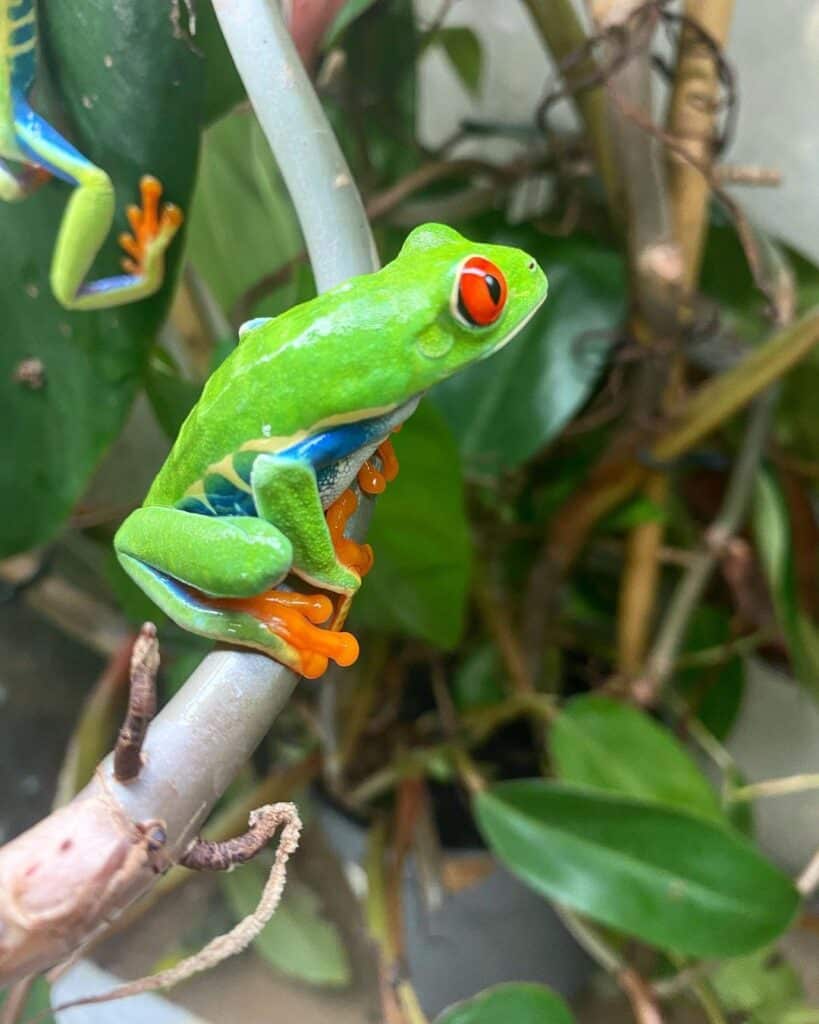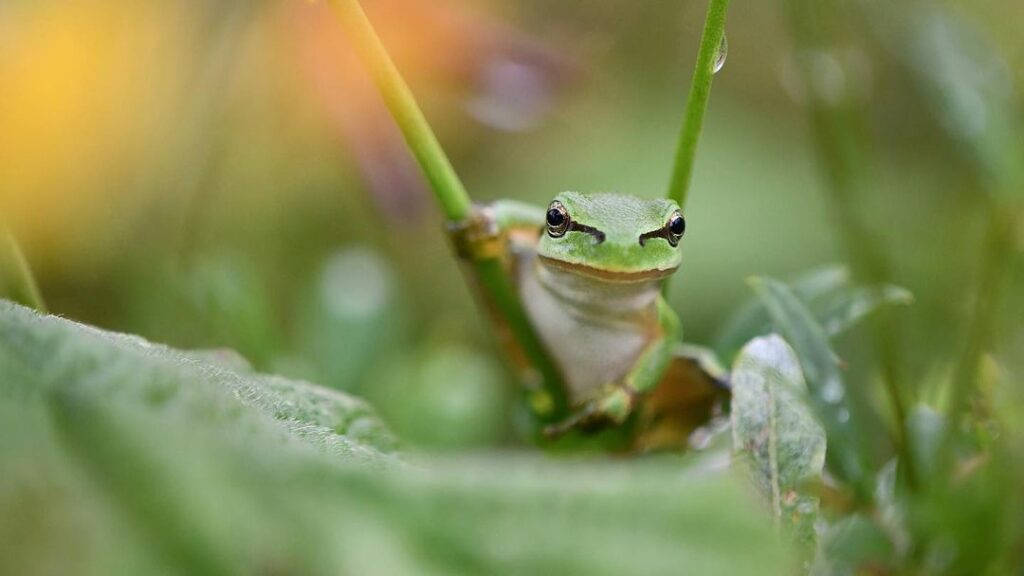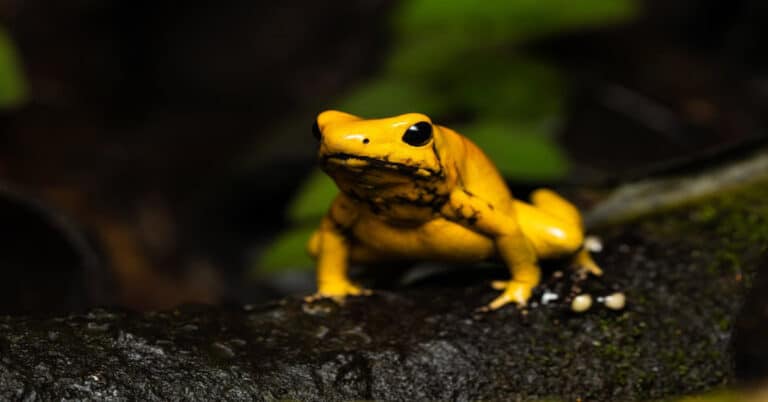Tree Frogs – All-About Small & Mighty Amphibians
Tree frogs are fascinating amphibians that spend most of their lifespan living in trees. Those tiny creatures are symbols of the natural world because of their ability to change colors, their adaptations, and their vocal abilities. They differ from others with their nocturnal activity and unique calls. That’s why tree frogs are more often heard in their natural environment rather than seen.
Below in this article, we will explore tree frogs to learn more about their physical characteristics, and behavioral adaptations.
What Do Tree Frogs Look Like?
Over 800 different kinds of amphibians make up the varied family of tree frogs. Tree frogs do not all reside in branches. The trait that distinguishes them instead has to do with their feet, because the final bone in each of their digits, known as the terminal phalanx, resembles a claw.
In addition to having toe pads that aid in climbing, tree frogs frequently have additional skeletal components in their toes. Although there are many different colors for tree frogs, the majority of the species in the United States are green, gray, or brown. Some of them have the capacity to shift color like chameleons, such as the squirrel tree frog.
Although tree frogs can reach a variety of sizes, the majority of arboreal species are very tiny because they are supported by leaves and thin limbs. The biggest tree frog in the world is the white-lipped tree frog, which is native to Australia and Oceania and measures 4 to 5.5 inches (10 to 14 centimeters) long.

Habitat of Tree Frogs
The majority of tree frog species – 600 in total – can be found in Central and South America, but they can be found on every continent but Antarctica. There are about 30 different types in the warmer regions of the Southeast. The majority of species, though not all, live in trees, which explains why they have long legs and toe cushions to aid in climbing and jumping.
Non-arboreal species dwell in pools and lakes or among wet vegetation. Tropical plains in southern Mexico, Central America, and northern South America are home to red-eyed green frogs. They lurk in the foliage of the rainforest at night.
What Do Tree Frogs Eat?
When they are in their native habitats, adult tree frogs have opportunistic feeding habits and are insectivores. Their regular diet usually consists of arthropods, including mealworms, crickets, moths, ants, and spiders. On the other hand, they modify their diets to reflect the easily accessible materials in the nearby environment.
For instance, the American green tree frog usually lives in marshy environments and relies primarily on insects like flies and mosquitoes for food. The bulk of the diet of the gray tree frog consists of ants and beetles.
Flying invertebrates like flies, moths, and grasshoppers are among the favorites of the red-eyed tree frog. However, it will rarely eat smaller amphibians if there isn’t any other dietary supply. Additionally, both Japanese tree frogs and Cuban tree frogs also engage in this type of eating.
However, tadpoles and young amphibians require a distinct diet. They eat algae and other watery vegetation because they are plentiful and easy to obtain. Vitamin C, which is essential for a tadpole’s growth and maturation into a mature frog, is also abundant in these plants.
Hunting Habits of Tree Frogs
The tree frogs have comparable hunting and eating habits, even though they can inhabit various environments and consume a variety of insects. They primarily forage at night because they are nocturnal creatures.
Because of how well-adapted their pupils are to dim light, they can see their prey in the dark. The forward-facing pupils of tree frogs allow them to track the insects more closely and hit them more precisely.
The agile food is preferred by many tree frogs over the larger prey. This is so that frogs can swallow their food whole since they are unable to chew. Some varieties of tree frogs are known to consume tiny bats or even snakes, though.
The soles of tree frogs are sticky. They can hang on to different surfaces and move closer to their target thanks to the sticky fluid that fills their toe pads. The mouths are used to capture their food. They then grasp their prey in their powerful jaws and push it into their mouths using their front legs.
The saliva of tree frogs is as viscous as honey, but it becomes liquid once the food enters the mouth. In this manner, the target is completely coated in saliva, making it difficult for it to flee.
How Long Do Tree Frogs Live?
Depending on the variety, tree frogs have different life spans. While some may only survive a few years, others may live for 15 years or longer. The lesser varieties are thought to have a brief lifespan of 1 or 2 years.
They typically live between 3 and 6 years, but they can live up to 20 years if they have a comfortable, secure environment like your house. Tree frogs can thrive in homes and live extended lives because they can survive longer in confinement than in the wild.
About 1 in 50 eggs successfully undergo the transformation into a froglet without being consumed or perishing from excessively hot or frigid water temperatures. For this reason, a single brood of eggs from hundreds to thousands of eggs is laid by a frog.
Even for a beginner, tree frogs require little upkeep to maintain their health. Tree frogs are easy to keep in their proper habitat, and they only require feeding every two to three days.

Oldest Living Tree Frog
Fred, the eldest tree frog in the world, resides in Australia. Fred was saved from certain death in 1977 by a three-year-old. While on holiday, Chris Humfrey discovered Fred scaling the walls of a Coffs Harbor restroom block. He then reared Fred in confinement to give his amphibian pet the best possible existence. Three years later, in 2017, the frog marked its 40th birthday.
Are Tree Frogs Poisonous?
Because all frog species release toxic compounds through their skin that may or may not be dangerous to people, handling them should be done with extreme care. Some frog species can be toxic or even fatal to people, while others won’t hurt anyone, not even pets, no matter what species they are.
The non-poisonous amphibian group includes tree frogs. Tree frogs can nevertheless secrete toxins that, while possibly not hazardous to people, may be detrimental to other creatures. The degree of toxicity in tree frogs varies by species.
Some tree frog species have toxic organs that they release poison through. However, the majority of tree frog poisons do not harm or kill people. As a result, tree frogs are typically neither harmful nor aggressive, nor are they toxic. However, holding or touching them can still result in skin irritations, allergic reactions, and other symptoms.
Despite having strong emetic poisons, some tree frog species, like the green and gray tree frogs, do not hurt people. These two frogs are among the best-known in Georgia and Louisiana, where they are also well-liked as pets.

How to Get Rid of Tree Frogs?
Having a tree frog infestation can be pretty frustrating. They may infest your property, obliterate your gardens, sully your house and yard, spread disease, or even attract snakes. Most residents with frog infestations are very concerned about getting rid of them.
So, here are some instructions on how to get rid of amphibians at your house:
Remove Food Source
Frogs eat invertebrates such as flies, mosquitoes, beetles, roaches, and others to survive. To get rid of them, you must take away their supply of food. You should switch off the lights at night because, particularly at night, bugs attract frogs. Use pesticides to manage insects around your pond or pool because they attract frogs.
Make sure you don’t have any pet food laying around because frogs consume pet food.
Create Dry Environment
A frog’s life cycle begins with embryos, from which tadpoles emerge before a mature frog is produced. Scoop out the clumped eggs or tadpoles from a frog-infested pond or pool and set them out to dry. If the eggs were allowed to dry out, they would not emerge, similar to how a tadpole without water would perish.
Create A Barrier
You might have a frog infestation if you reside close to a lake or other large body of water. Although frogs can leap a limited distance, they do so frequently. Put up a fence or barricade around your house’s boundaries if you want to keep frogs out. To build a barricade against the frogs, use barbed wire, plastic, or netting. You can build a fortification around your pond to keep amphibians out and keep the area free of them.
Bottom Line
In this article, we explored the characteristics of tree frogs. Tree frogs are an interesting and significant species that are essential to preserving the environment’s equilibrium. They are ubiquitous and not in danger of extinction, but scientists are unsure of their exact population size globally. That is why it’s important to protect the species and not interrupt their natural habitat.

Nato is a content writer and researcher with a background in psychology who’s eager to explore the wonders of nature. As a travel enthusiast and animal lover, she hopes to inspire others to discover and cherish the beauty and importance of the natural world.







